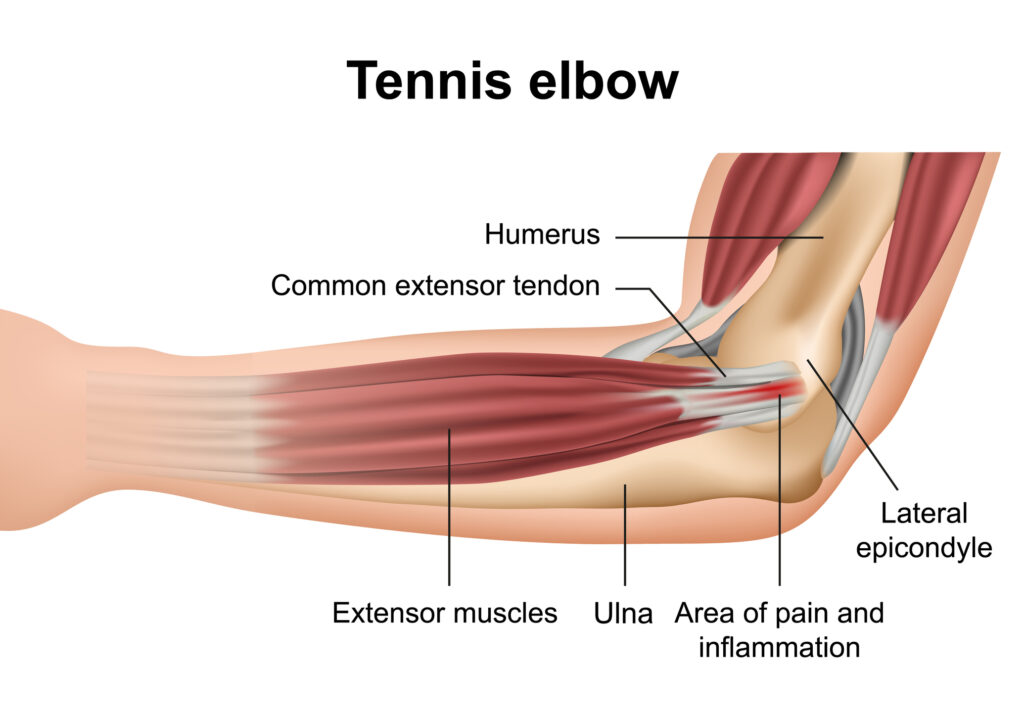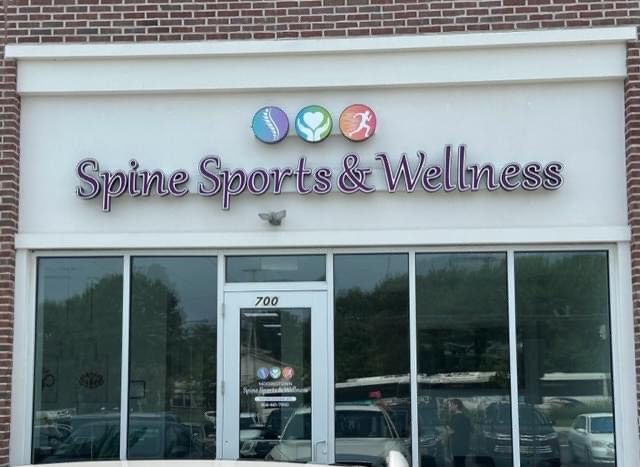Tennis elbow also known as Lateral Epicondylitis is a common health problem. If you have tennis elbow, you probably have pain that originates over the outside (lateral) aspect of the elbow. Often, the pain can radiate up the arm and down the forearm with activities.
Tennis elbow is caused when the attachment of a tendon to the outside bone at the end of the humerus is irritated. This tendon attachment can degenerate over time and with normal wear-and-tear. Doctors refer to this degeneration as tendinosis. Unfortunately, tendinosis is often a natural part of the aging process and there is really no way to prevent it.
The tendons that attach to the outside of the elbow also cross the wrist. These tendons connect to both the wrist and fingers. Because of this, when you use your hand or wrist, it will often also hurt your elbow. For example, if you grab a coffee mug or shake hands, it will hurt your elbow because they are all connected. It may not make sense to have elbow pain when you use your fingers, but it is common, and that connection is the reason the pain occurs.
What are Possible Causes of Elbow Tendonitis?
- Repetitive movement
- Heavy lifting
- Squeezing and twisting movements
- Computer use
- Gardening
- Painting
- Tennis
- Golf
What are Symptoms of Elbow Tendonitis?
Symptoms may include feeling pain and tenderness on the bony part of the outside of the elbow. Even though the injury is to the elbow, pain can be aggravated by doing things with your hands. This is because you use your tendons when using your hands, which causes pain to radiate up into your elbow.
Do I Have Tennis Elbow or Golfer’s Elbow?
Tennis Elbow (Lateral Epicondylitis) is on the outside of the elbow, and Golfer’s Elbow (Medial Epicondylitis) is on the inside part of the elbow.
A backhand in tennis requires a stable wrist. Over time, this places stress through the tendons in the back of the wrist. This may lead to tendonitis at the elbow or tendonitis of the wrist. However, tennis is not usually the main cause of Tennis Elbow. Swinging a golf club can put stress on the inside of the elbow and lead to Golfer’s elbow. This is rarely the cause, though. Tennis Elbow and Golfer’s Elbow are both types of tendonitis. They can be caused by repetitive stress or vibration.
Can Shoulder Exercises Help Elbow Tendon Pain?
Exercises for the shoulders are important for those with elbow tendonitis. This is because the pain in the elbow can lead to decreased use of the entire arm. Lack of arm use can cause weakness and stiffness to develop in the shoulder. So, if you have elbow tendonitis, keep the shoulder moving. It may not directly affect the elbow pain, but it can help to prevent other issues from developing.
What are Some Effective Ways to Treat Elbow Tendon Pain?
- Rest from the activity that causes the pain. Take a few days to a few weeks off.
- Non-steroidal anti-inflammatory drugs (NSAIDs) can help decrease pain. There are risk factors. Please speak to your physician before beginning any medications, even if they are over the counter.
- Ice / cold packs help to decrease pain and limit damage to surrounding tissue.
- A counterforce elbow brace may temporarily help. A tennis elbow brace applies pressure just below the elbow taking tension off the inflamed tendon. Additionally a wrist brace can help. Please talk to your physician for proper use of braces.
- Stretching the wrist into flexion or extension can help to stimulate the injured tendons and promote mobility and healing. Hold stretches for 30 seconds and repeat 3 times. You should feel tension but not severe pain.
- Massage and gentle rubbing of the painful tendon can help to stimulate healing and breakdown scar tissue. Try massaging the tendon in various directions.
How Long Does Elbow Tendonitis Take to Heal?
Recovery depends on the severity of the injury. Generally tendonitis can resolve on its own with the techniques described above. Many people feel better in as little as a couple of weeks, but it may take 6 months to a year for the tendon to fully heal. Surgery is rarely needed. But if the condition becomes chronic, we have non-surgical options for you to consider.
How is Elbow Tendonitis Diagnosed?
To diagnose your elbow tendonitis, your doctor will perform a thorough physical exam. The doctor will have you bend your arm, wrist, and elbow to see where the pain is located. Your physician will also determine if you also need tests, such as X-ray, MRI or ultrasound, to diagnose your elbow tendinitis.
Is Your Elbow Pain Interfering with Your Work, Your Play or Simply Living Your Life?
Is elbow pain keeping you from simple everyday tasks like drinking coffee, lifting a bag or driving? Don’t let your pain keep you down. At Concierge Back and Sports Medicine, we are performing a revolutionary procedure that is changing the lives of our patients for the better.
Percutaneous Tenotomy offers a safe, quick, minimally invasive solution to relieve pain, restore mobility and rapidly return patients to their previous activities. The procedure is performed in less than 20 minutes. Patients can choose to stay awake and alert throughout (only a local anesthetic is used), and no sutures or stitches are needed—only a small adhesive bandage is required. Most patients can return to normal activity within 6-12 weeks.
Have You Been Told That Surgery Is Your Only Tennis Elbow Treatment Option?
Are you silently suffering because you were previously told there is no other option for you but a major or invasive surgery with a long recovery? Or are you at a point where ice and stretching is not going to make your pain disappear?
If you have tried physical therapy, cortisone injections, medication, or just taking time to ice, stretch and rest and are still in pain, contact us for a consultation. We have a solution that does not involve general or open surgery, may give you quick pain reduction and should have you back to enjoying the things you love in a few weeks to a few months.
Percutaneous Tenotomy is a safe, quick procedure specially designed for those who are suffering from painful conditions associated with tendon damage, commonly referred to as pain in the rotator cuff, Tennis or Golfer’s elbow, Runner’s or Jumper’s knee, Achilles tendonitis.
Percutaneous Tenotomy combines ultrasound imaging (which is also used to see a baby in the womb) to identify damaged tissue. A specialized needle is used to break down and remove only the damaged tissue that causes pain. Removing the damaged tissue allows the tendon to heal and provides pain relief. The procedure is not open surgery and can be performed in an office or outpatient surgery procedure room.
Benefits include:
- Quick pain relief
- Rapid return to normal activities
- Local anesthetic used instead of general anesthesia
- No sutures or stitches (requires only a small, adhesive bandage)
- Minimally invasive, not open surgery
At Concierge Back and Sports Medicine, we don’t want you to suffer with elbow or other joint pain. We are happy to discuss treatment options and a wellness plan that may work for you. Please call our office at (267) 551-4200 to schedule a consultation or visit us online HERE. You can also find more information on the procedure HERE.



